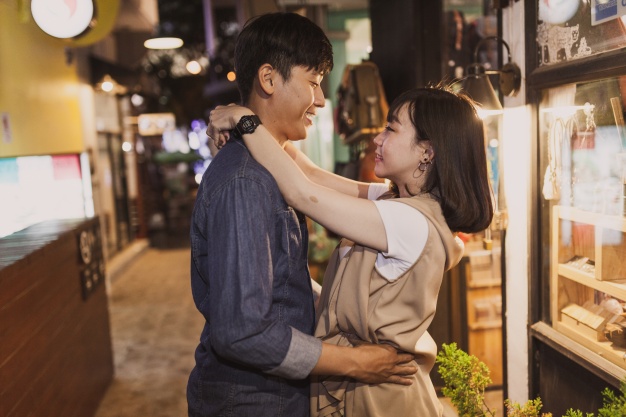Have you wondered how a long good hug could CALM you down? What about one that calms down BOTH of you? Learn how to calm yourself down WHILE IN RELATIONSHIP with a simple technique called “hugging until relaxed”. It’s a great way to get in touch with your partner while also maintaining connection with yourself.
To begin with, practice relaxing all your muscles. Being fully relaxed means being relaxed all the way inside ones body. Our ears can be relaxed, our legs, the inside of our mouths. Our minds can be relatively quiet. Quiet does not mean blanking out. Here, it means to find the presence of peace inside you. Find that place of stillness, goodness, home inside.
A good way to begin is to learn tense/relax muscle relaxation and combine that with deep breathing. Do not let the simplicity of this muscle relaxation fool you. With this technique, clench and tighten each muscle area and then release them. For example, squeeze your hand tightly. Then let it go fully. Repeat that three times. With each squeeze take a deep belly in breath, all the way in from the belly first. With each release let the breath out fully. Breathe with the belly first, not your upper chest. Repeat that sequence all over your body: arm, chest, stomach, back, etc. At first keep it general, but after a few weeks try including things like relaxing your forehead, your jaw, your foot arch, etc.
This can help in relationship by coming from a place of calm inside, so we feel more secure within ourselves. No need to get your partner to do things a certain way, as one is more stable inside through relaxing oneself. This keeps boundaries clearer, so the need to be enmeshed to feel loved quiets down and stops. When you know how to make yourself feel safe inside, you can open up to your partner in new ways, and take more risks, which deepens intimacy. The best news is also is your sex can get much, much better! When a couple is fully relaxed it’s amazing how good the sex can be.
Now that you’re ready and calm, your heart rate is slowed, stand facing your partner, with a balanced, grounded stance, over your own two feet. Close your eyes, breathe deeply, and relax yourself again. Then open your eyes, and when ready, move forward slowly while staying relaxed so that you have one foot between your partner’s. Notice how easy it is then to put your arms around your partner without going off balance. Get comfortable. Remember to breathe and relax yourself first. Let the feelings arise without believing you are just these feelings as your breathe/ground in your body. Note if you feel like backing up or resisting, but don’t give in to that. Give yourselves several minutes to hug, relaxing yourselves from within, while in contact with your partner, holding them without leaning in to them or leaning away from them. Later, talk about your experience with your partner. Why not practice this several times a week for a few months? . It’s a technique I learned many years ago, and is described more fully in David Schnarch’s excellent book Passionate Marriage. I often use this technique in couples counseling with great results.
Why is hugging til relaxed necessary? In my experience it relates to the normal tension and anxiety that happens when couples are co-dependent on each other for their individual well-being. It shows up in sessions while practicing this hug when one person overly leans in or on their partner, and/or the other person overly leans away. They haven’t learned to stand tall within themselves, so their usual hugging/relationship is based on instability. One may have a perceived need to “lean in” for stability, which means they have to control the other to maintain that stability. Which means the other may distance themselves for their own stability. One is chasing for more intimacy, which makes the other distance themselves for self-protection. This pressure/dance begins to get irritating after a while, and couples come in to my office in distress from fighting so much. The distancing person irritates the chaser/leaning-in person, and around and around the pattern goes in a circle; very frustrating. We can never relax into the relationship. Similarly we can never relax into being ourselves and that is where problems arise. The relationship begins to become about identities based on pursuit and distancing. One person chasing the other for more intimacy, unconsciously knowing full well that the chase will just make the other person distance.

How Can Therapy Help?
In therapy I teach how a body-centered connection inside means not losing yourself in the relationship yet maintaining high degrees of interpersonal intimacy. It sounds easy but like many things it takes some practice and work. Therapy can teach you that this irritating normal anxiety doesn’t have to become so UNBEARABLE to both people, usually by bickering and fighting too much. So often I begin with teaching relaxation hugging instead of returning to everyone’s remembrance of romance, or communicating better. Later in therapy communication and how to deepen intimacy happens, yet when a couple is fighting intensely, the first things to learn are boundaries and relaxation!
Conclusion
Hugging until relaxed helps us to remember that calming oneself down FIRST can put an end to escalating fights, plus enhance intimacy! Remember to breathe deeply, then move closer to your partner, feet in between you both, as you stand while holding one another. Relaxing in to calming yourself down while gently holding your partner, the idea being to relax yourself while contacting the other through your eyes. Careful to not lose your contact within when your partner makes a face or other distractions happen. Individually, one can practice this skill through centering or meditation. As a couple, why not practice a few times a week as you deepen your skill at your own contact inside yourself, while also appreciating the gentle hold of your partner. This can be a start towards a more active foreplay/breathing together to deepen your sexual intimacy. All from a calm hug beginning!
Jim Bowen MA LPC has been assisting individuals and couples since 1992, with offices in Boulder and Denver. Contact Jim with email or call him at 303-534-8717. Why not call for a free consultation?


